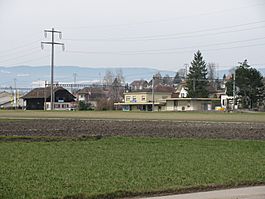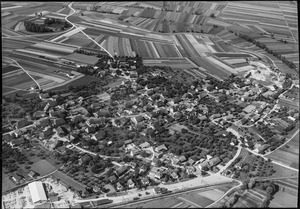Müntschemier facts for kids
Quick facts for kids
Müntschemier
|
||
|---|---|---|

Müntschemier village station
|
||
|
||
| Country | Switzerland | |
| Canton | Bern | |
| District | Seeland | |
| Area | ||
| • Total | 4.87 km2 (1.88 sq mi) | |
| Elevation | 438 m (1,437 ft) | |
| Population
(Dec 2020 )
|
||
| • Total | 1,561 | |
| • Density | 320.5/km2 (830.2/sq mi) | |
| Postal code |
3225
|
|
| Surrounded by | Brüttelen, Treiten, Kerzers, Ried bei Kerzers, Murten, Bas-Vully, Ins | |
| Twin towns | Hardheim (Germany) | |
Müntschemier (which is Monsmier in French) is a small town, also called a municipality, located in the Seeland area of the canton of Bern in Switzerland.
Contents
History of Müntschemier
Müntschemier was first mentioned in old records way back in 1185. Back then, it was known as Munchimur.
Early Settlements and Rulers
The very first signs of people living here are some old stone tools from the Mesolithic period (Middle Stone Age). These tools were found in an area called Baholz-Oberfeld. Other ancient discoveries include a Bronze Age grave or settlement ruins in the Müntschemier marsh, and a Roman era burial site at Gugleracker.
In 1185, a religious group from the Abbey of St. Johannsen started to rule over the village. Later, in 1474, the whole area around Erlach, including Müntschemier, was bought by Bern. Müntschemier then became part of the Bernese court of Ins.
Changes and Growth
In 1827, a part of the village was sadly destroyed by a fire, but it was quickly rebuilt. A big project called the Jura water correction happened between 1874 and 1883. This project helped drain the Grand Marais marsh, which was a large swampy area. Draining the marsh created lots of rich farmland, allowing the village to grow.
Better transportation also helped Müntschemier grow. A major highway was built through the Grand Marais between 1858 and 1863, connecting the village to other parts of the country. Then, in 1902, a railway line between Bern and Neuchatel opened, making travel even easier. These transport links led to more people moving to the village.
In 1956, a freight yard and warehouses were built. This made Müntschemier an important center for growing and shipping vegetables all over Switzerland.
Geography of Müntschemier
Müntschemier covers an area of about 4.9 square kilometers (or 1.9 square miles). A large part of this land, about 77.9%, is used for farming. Forests cover a small part, about 1.8%. The rest of the land, around 18.6%, has buildings and roads. A tiny bit (0.6%) is rivers or lakes, and 1.0% is land that can't be used for anything.
Most of the built-up area is for transportation (7.4%), houses (5.7%), and industrial buildings (3.3%). The municipality is located in the Grand Marais, which is a very fertile area with dark, rich soil in the Bernese Seeland.
Müntschemier is also located on the main railway line that connects Neuchâtel and Bern. The S5 train line stops right there.
On December 31, 2009, the old administrative district of Erlach was closed down. The very next day, Müntschemier became part of the new Seeland administrative district.
Müntschemier's Coat of Arms
The blazon (official description) of Müntschemier's coat of arms is: The shield is split down the middle into gold and silver. On top of this, there is a red hill with three peaks. On the right side, an alder tree with a green top and a silver trunk grows from the hill. On the left side, a golden ear of grain also grows from the hill. This design represents the town's natural features and farming history.
Population and People
Müntschemier has a population of about 1,400 people (as of 2022). About 27% of the people living here are foreign nationals. Over the last ten years (from 2000 to 2010), the population grew by about 17.7%.
Languages Spoken
Most people in Müntschemier (about 81.7%) speak German as their main language. The second most common language is Portuguese (9.6%), followed by French (3.3%). A small number of people also speak Italian.
Where People Come From
In 2000, about 41.6% of the people living in Müntschemier were born there. Another 25.1% were born in the same canton (Bern). About 15% were born elsewhere in Switzerland, and 17.7% were born outside of Switzerland.
Age Groups
As of 2010, children and teenagers (ages 0-19) make up about 21.6% of the population. Adults (ages 20-64) make up 64.5%, and seniors (over 64 years old) make up 13.9%.
Population Over Time
The chart below shows how the population of Müntschemier has changed over many years:

Economy and Jobs
In 2011, Müntschemier had a low unemployment rate of 1.84%. This means most people who wanted jobs had them. In 2008, there were 926 people working in the municipality.
Types of Jobs
Jobs are often grouped into three main types:
- Primary sector: These jobs involve getting raw materials from nature. In Müntschemier, about 115 people worked in this sector, mostly in agriculture (farming).
- Secondary sector: These jobs involve making things. About 193 people worked in this sector, with most (90.1%) in manufacturing and some (10.4%) in construction.
- Tertiary sector: These jobs involve providing services. About 618 people worked in this sector. Most of these jobs (85%) were in sales, retail, or car repair. Others worked in transport (7.5%), hotels or restaurants (2.1%), education (1.4%), and healthcare (0.5%).
About 40% of the workforce in Müntschemier were women.
Commuting to Work
In 2000, about 284 workers came into Müntschemier for their jobs, while 294 workers left the municipality to work elsewhere. This means slightly more people leave Müntschemier for work than come in. About 12.2% of working people used public transport, and 41.3% used a private car to get to work.
Religion in Müntschemier
Based on the 2000 census:
- About 20% of the population were Roman Catholic.
- About 71.2% belonged to the Swiss Reformed Church (a type of Protestant church).
- A small number of people (about 3.43%) belonged to other Christian churches.
- About 1.17% of the population were Islamic.
- There were also a few people who were Buddhist or Hindu.
- About 2.8% of the population did not belong to any church or were agnostic or atheist.
Education System
In Müntschemier, about 34.5% of the population have finished non-mandatory upper secondary education (like high school). About 6.9% have gone on to higher education, such as university or a specialized college.
School System in Bern
The school system in the Canton of Bern works like this:
- There's one year of non-mandatory Kindergarten.
- Then, six years of Primary school.
- After that, three years of mandatory lower Secondary school, where students are grouped by their abilities.
- After lower Secondary, students can choose to continue their schooling or start an apprenticeship (learning a trade on the job).
Students in Müntschemier
During the 2010-2011 school year, 116 students attended schools in Müntschemier.
- There were 2 kindergarten classes with 26 students. About 38.5% of these students were not Swiss citizens, and 38.5% spoke a different language at home than in the classroom.
- There were 5 primary classes with 90 students. About 27.8% of these students were not Swiss citizens, and 26.7% spoke a different language at home.
In 2000, 6 students living in Müntschemier went to schools outside the municipality, while 6 students from other towns came to school in Müntschemier.
International Connections
Müntschemier has a special connection with another town through a program called town twinning.
Twin Towns
Müntschemier is twinned with:
- Hardheim, Germany
See also
 In Spanish: Müntschemier para niños
In Spanish: Müntschemier para niños





